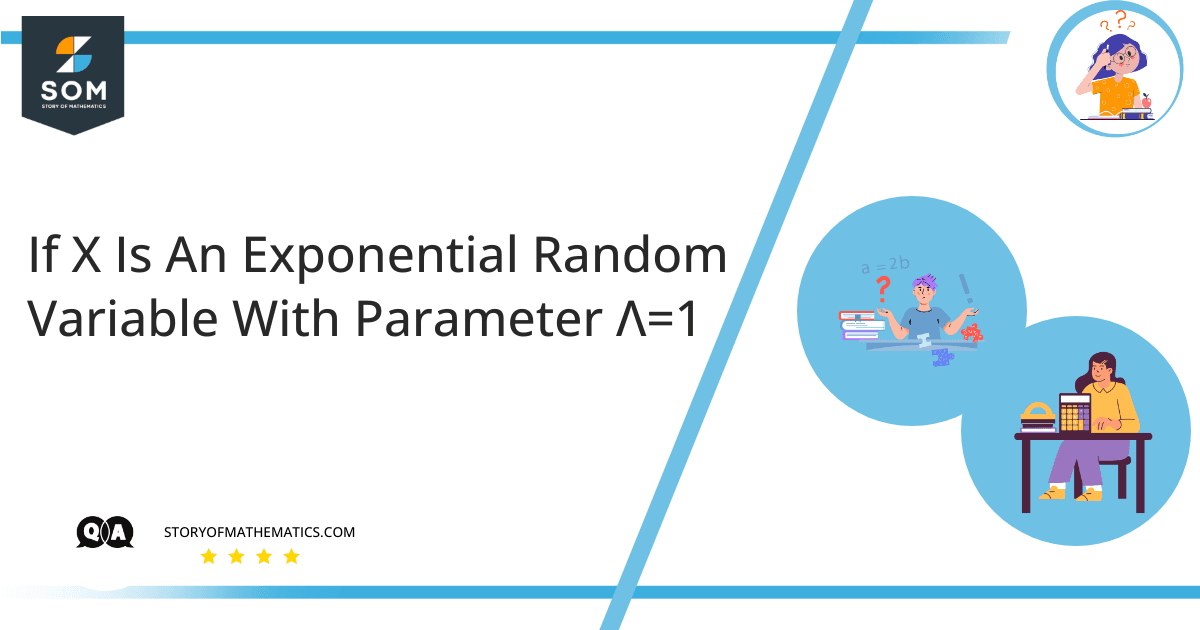
This problem aims to familiarize us with the probability density functions. The concepts required to solve this problem are continuous random variables and probability distributions, which include exponential distribution and densities of random variables.
A probability density function or PDF is used in probability theory to describe the probability of a random variable staying within a particular range of values. These types of functions describe the probability density function of normal distribution and how there exists mean and deviation.
The cumulative distribution function or CDF of random $x$ is another way to represent the distribution of random variable, defined as:
\[ F_X (x) = P(X \geq x),\forall x\in\mathbb{R}\]
Whereas a continuous random variable has an exponential distribution having $\lambda > 0$ if the density of the function is:
\[f(x) = \lambda e − \lambda x \space\space\space if \space x \geq 0\]
Expert Answer
Let’s first compute the exponential distribution of $x$:
\[ P(X > 1) = \int e^{-x} dx = e^{-x} \]
\[ F_x = 1 – P(X > 1) = 1 – e^{-x} \]
We are going to use this approach to find the exponential distribution of our function:
\[ Y = \ln X \]
Since exponentials are memoryless, we can write:
\[ F_Y (y) = P(Y \leq y) \]
Plugging in the value of $Y$:
\[ F_Y (y) = P(\ln X \leq y) \]
As exponential is the inverse of the log, we can get ride it by:
\[ F_Y (y) = P(X \leq e^y) \]
\[ F_Y (y) = F_X (e^y) \]
Then,
\[ F_x (e^y) = 1 – P(X > e^y) = 1 – e^{-e^y} \]
Now we are going to calculate the probability distribution function, which is the derivative of the cumulative distribution function $F(x)$:
\[ f(x) = \dfrac{d}{dx} F(x) \]
Substituting the values gives us:
\[ f_Y (y) = \dfrac{d}{dy} F_Y (y) \]
\[ f_Y (y) = \dfrac{d}{dy} F_X (e^y) \dfrac{d}{dy} \]
\[ f_Y (y) = \dfrac{d}{dy} \left [1 – e^{-e^y} \right ] \]
\[ f_Y (y) = -(-e^y) (e^{-e^y}) \]
\[ f_Y (y) = e^y e^{-e^y} \]
Numerical Result
The probability distribution function is:
\[ f_Y (y) = e^y e^{-e^y} \]
Example
Let $X$ be a discrete random variable handling positive value integers. Suppose that $P(X = k) \geq P(X = k + 1) \forall$ positive integer $k$. Prove that for any positive integer $k$,
\[ P(X = k) \geq \dfrac{2E [X] }{k^2} \]
Since $P(X = I) \geq 0$, it can be said that for any $k \in \mathbb{N}$,
\[ E [X] = \sum_{i=1}^{\infty} iP(X = i) \geq \sum_{i=1}^{k} iP(X = i) \]
Moreover,
\[ P(X = k) \geq P(X = k + 1) \forall k \in \mathbb{N} \]
We have,
\[ P(X = k) \geq P(X = i) \forall i \geq k \]
Finally,
\[ \sum_{i=1}^k iP(X = i) \geq \sum_{i=1}^k iP(X = k) \]
\[ \dfrac{k(k + 1)}{2} P(X = k) \]
\[ \geq \dfrac{k^2}{2} P(X = k) \]
Hence, we can say that,
\[ E [X] \geq k^2 P(X = k)/2 \]
Proved!
